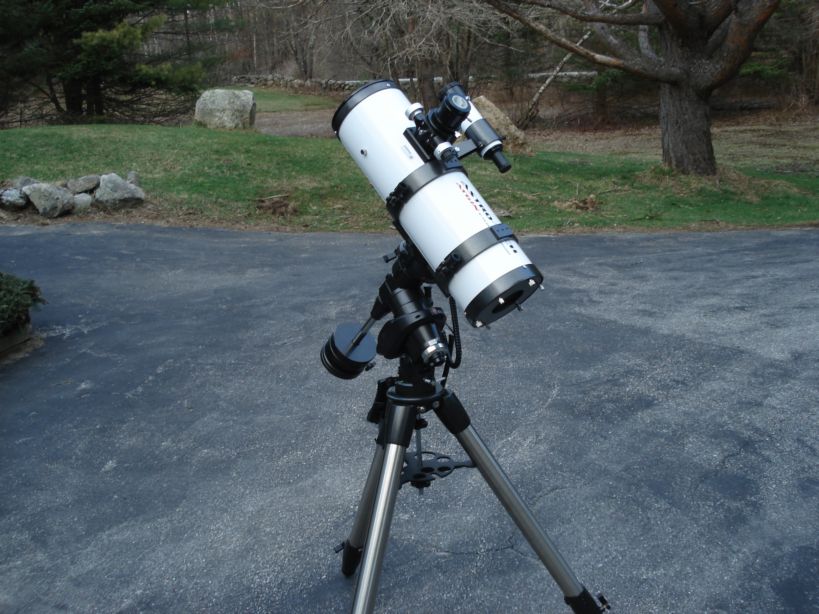
By Ed Ting
Updated 9/18/11
1) Astro-Tech AT6IN Imaging Newtonian
2) Orion StarBlast 4.5 Equatorial Newtonian
(6" f/4 Reflector, OTA, 8X50 finder, rings + dovetail plate, 2 speed Crayford focuser w/ extension tube, $299 + shipping)
And the bargains, they keep on coming. Introduced at the beginning of 2011, Astro-Tech's line of imaging Newtonians offer some of the best values in astronomy today. As of this writing, there are 6", 8", 10", and 12" versions of this scope. The 8", 10" and 12" models appear to be very similar to OTAs sold by Orion for about the same price (Orion does not have the 6" model as of right now.)
This was an impulse buy at NEAF 2011. I've had an interest in this scope ever since spending time with the Orion version of the 8" model. I found the 8" a little big and heavy for my CG-5, and figured the smaller 6" might be just right. I went to NEAF determined not to buy anything, but as soon as I saw the scope in Astro-Tech's booth, I was powerless to resist. My friend, who had driven me down to the show, took one look at the carton I was carrying and promptly went back and bought one for himself. It turns out he got the last one. You gotta act fast at these shows.

Astro-Tech's new AT6IN on the CG-5. 7 and 4 lb counterweights attached.
The scope was very carefully packed - there was so much packing material that it took a bit longer than usual to get the OTA assembled and on the CG-5. The scope is really short. There's so little real estate behind the focuser that the supplied rings actually get in the way. Look at the photo above and you can see that I've slid the rings all the way up to the focuser. This is not ideal because you may need to loosen the rings to rotate the tube (and the rings are tight by the way, just like on the 8" f/4 scope.) But even in this position, I still wanted to slide them even more forward, for balance. Sure, you can slide the dovetail plate and get the same result, but now the set screws on the CG-5 don't line up with the detents on the supplied plate. My solution was to substitute a shorter Vixen dovetail plate.
Astro-Tech lists the OTA at 9.5 lbs, but once your add the rings, plate, and 8X50 finder, the weight jumps to 13.4 lbs. While it's a far cry from the 20 lb weight of the 8" scope, the AT6IN is heavy enough that you'll need the 11 lb counterweight for the CG-5. I removed the 8X50 finder, used a shorter Vixen plate, and attached a Rigel Quik Finder. This reduced the weight to 12.4 lbs.
And how is the scope optically? If you take my comments about Orion's 8" f/4 Astrograph and shrink them 25%, you'll get a pretty accurate idea. My impression of the Orion was that you were buying a really nice focuser with a telescope attached, and this feeling is even stronger with the 6" - there's less scope to notice and the focuser becomes even more prominent. As with the 8", you can do visual observing, but the scope is really made for imaging. Even with the extension tube in place and the focuser racked all the way out, the scope still would not find focus with any of the TeleVue eyepieces I had. The solution was to raise the eyepiece a little and then clamp it with the set screw. This isn't exactly an elegant solution, and it sometimes had an effect on the apparent collimation.
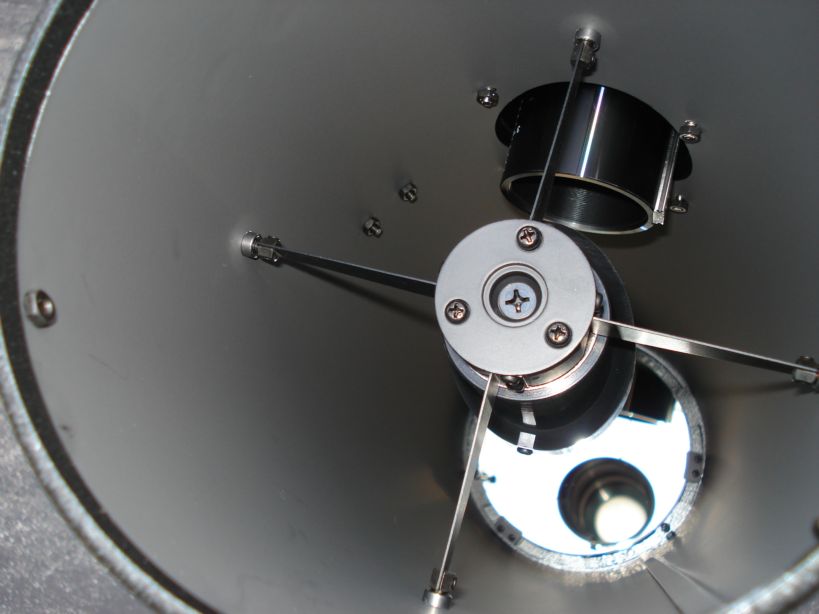
Looking down the tube
Oh yeah - about that collimation. The scope is extremely sensitive to misalignment. I spent a lot of time getting it just right, and even then, the apparent collimation changed depending on which eyepiece I used. 2" eyepieces seemed to give a different star test than 1.25" eyepieces. Still, the optics showed modest undercorrection. I couldn't find any specs for the secondary obstruction, but it's pretty big. Taking crude measurements with a ruler showed its diameter at around 61 mm, or 40%. With low power eyepieces like the 27 mm Panoptic (about as low as you'll want to go given the huge exit pupils generated by an f/4 scope) stars became comets in the outer half of the field. I didn't have Astro-Tech's coma corrector ($135) handy, but I'd say it's necessary for serious visual use, and mandatory for imaging. You can simulate the effect of a coma corrector by using a barlow. The weakest barlow I have is a 1.8X TeleVue. I wound up leaving it in there for almost all of my visual observing sessions. So, for me, the scope wound up being a 1080 mm f/7.2 reflector.
Did I mention that the scope is short? Although its focal length is small at only 600 mm, the tube still seemed too short. Again, taking a ruler to the tube, the distance from the front of the primary to the plane of the secondary mirror is only about 330 mm. That's right, folks - almost half of the optical path takes place after the light hits the secondary.
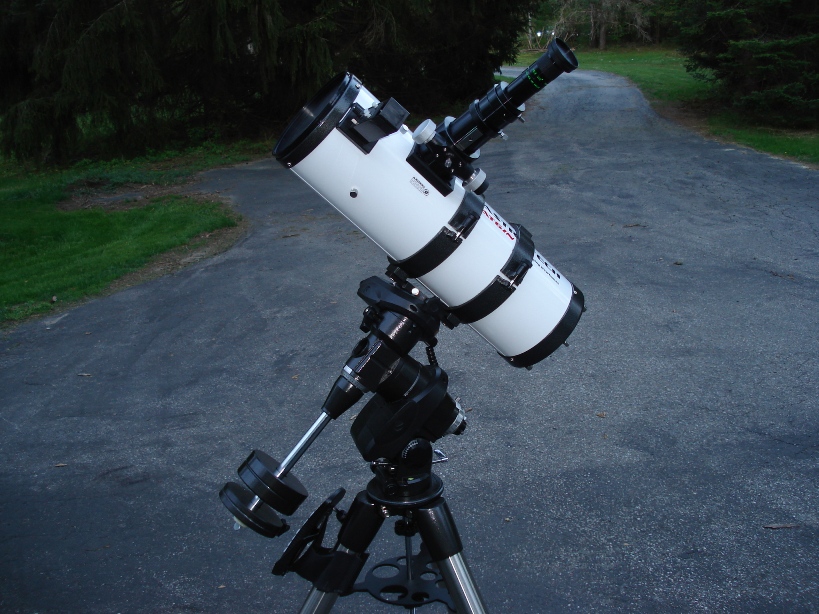
The configuration I finally settled upon - shorter Vixen dovetail, Rigel finder in place of 8X50, and TeleVue 1.8 X barlow.
Check out the height of the focuser stack!
All of this conspired to make the visual experience of the scope a little compromised. Low power sweeping with a scope like this sounds like a good idea, but the comets near the edges detracted from the experience. If you're searching for a planetary nebula, for example, and it's not in the center of the field, it's hard to know where to pan to because all of the objects near the edges look like they could be non-stellar targets. This happened to me one maddening night where I was sure I saw the Eskimo near the edge of the field. When I centered the scope on the object, it turned out to be a star. But then I was sure I saw something fuzzy again at the edge, and so on. In a similar vein, I spent a frustrating night trying to navigate my way through the Virgo Cluster. Once I inserted the 1.8 X barlow, things got a lot better. But don't go too high with the magnification. Around 100X or so, images begin to break down. One night, Cassini's Division was plainly visible through my C90 and the C6, but was tough to see in the AT6IN. Also, using higher magnifications takes away one of the main pleasures of a scope like this - low power, wide-field sweeping.
On the other hand, imaging was a breeze with the scope. The focuser is a pleasure to use. With only 600 mm of focal length to work with though, planetary imaging is going to be tough unless you start stacking barlows. On the other hand, you can cover a lot of the moon, and (although I didn't do it) wide field deep sky imaging should be a lot of fun with the scope.
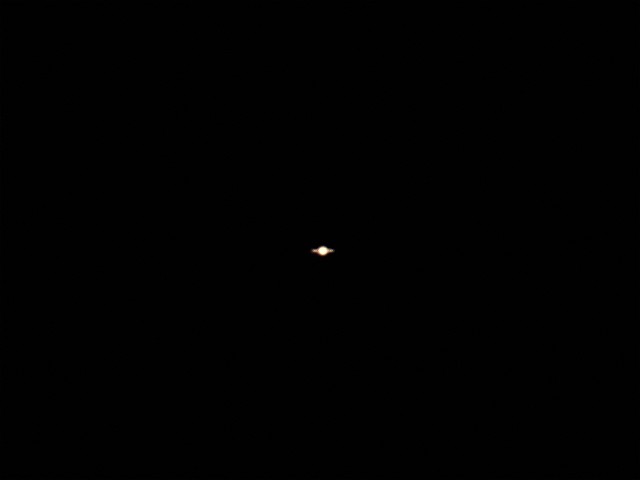
At only 600 mm, image scale on Saturn is really tiny. Have your barlows handy for planetary imaging.
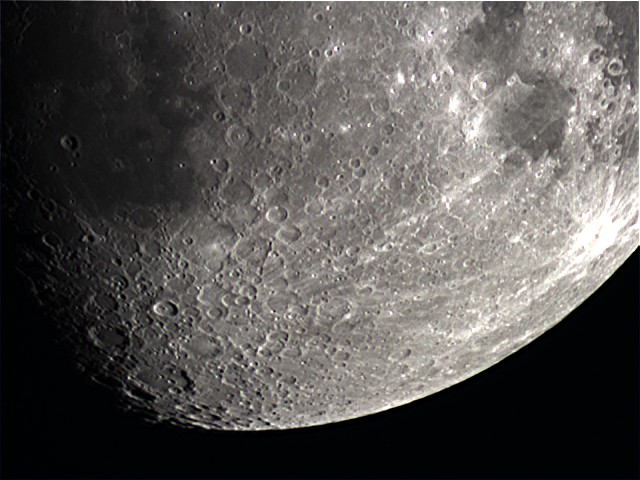
On the other hand, you can cover a lot of the moon
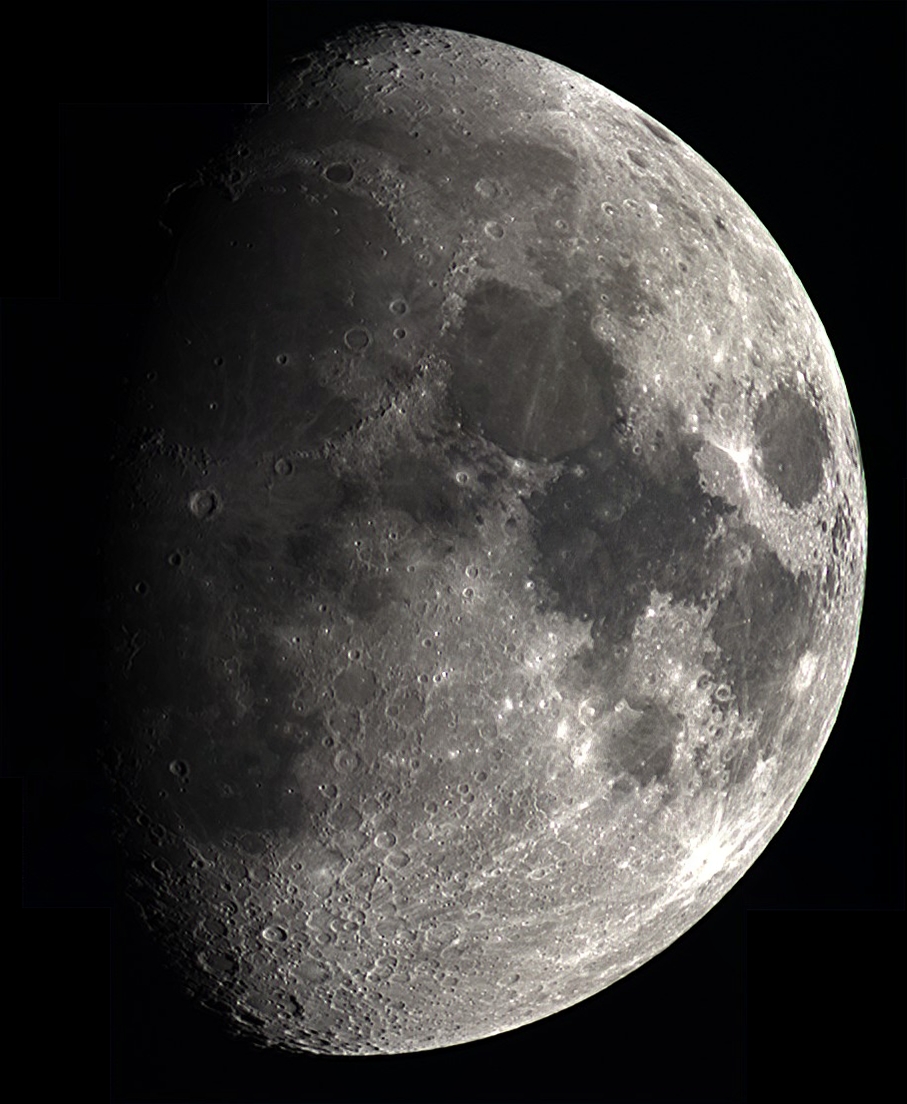
Full mosaic of the moon, stitched together from 7 individual frames
If I sound lukewarm about the AT6IN, it's mainly because the scope's intended purpose doesn't exactly mesh with my priorities. I don't do the kind of wide field deep sky imaging that the scope's good at, and visually it's got some compromises. Still, one can't complain too much. The price is so low they're practically giving them away; it's almost worth buying one just to get the focuser, finder, rings, and plate. The fact that all these nice parts are held together by a telescope is a nice bonus. Your move.
Update 8/31/11: I wound up selling the scope to local club member John R. John has a great deal more patience with collimation than I do, and reports that both the placement and the tilt of the secondary were still off. After several iterations, he was able to obtain an acceptable alignment and reports that the scope is OK visually when properly collimated.
2) Orion StarBlast 4.5 Equatorial Newtonian 9/18/11
(4.5" f/4 Equatorial Newtonian Reflector, EQ-1 mount, EZ Finder II reflex sight, 15 mm, 6 mm Expanse eyepieces, Starry Night Special Edition software, $219.95 + shipping)
Orion's StarBlast Dobsonian has been a favorite among kids, beginners, and budget-minded astronomers ever since its introduction in 2003. It's cheap, simple, reliable, and performs decently. Orion has been getting good mileage out of this model. The StarBlast is available in three different guises - as the traditional Dob, as an OTA for imaging, and now in this equatorial variant. It's certainly a good bargain - for only $20 more than the Dob, you get an equatorial mount and better eyepieces. The entire assembly is quite light at around 20 lbs (the Dob version tips the scale at an even lighter 13 lbs.)
I have a confession to make: I didn't expect to like this scope. The first time I had it out, I surrounded it with other telescopes that I've recently acquired - a wonderful 12.5" Obsession, and a Celestron C5 that I've been using for imaging the moon. The other scopes were there so I'd have something to look through when I got tired of the StarBlast. But as they say in football, at some point you need to stop talking and actually play the game. And so I did. So why did the StarBlast do so well, and why am I enthusiastically recommending it? Simple: Because it didn't do anything wrong. Serious audiophiles will point out that people like NHT, PSB, and Paradigm have been making great budget speakers for years - stuff that's miles ahead of the typical department store dreck. They've been doing it right under your nose and you've probably never been aware of it. Like budget speakers, budget optics are quite useable when properly designed, and when its sins are primarily of omission, rather than commission. The StarBlast equatorial is priced like a department store telescope, but it's in a different league altogether.
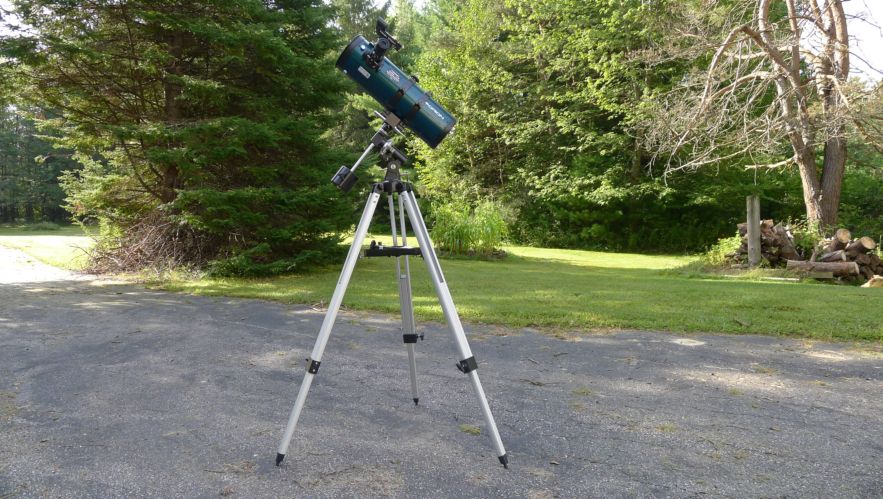
Orion's 4.5" Equatorial StarBlast
The optics are very well-corrected. I couldn't see any spherical aberration in the center of the field of view. This must be a really good sample (purchased anonymously by a friend via Orion's web site) as I've seen other StarBlast optics that were so-so. As you move away from the center, some distortion starts to creep in, and the outer 25% or so gets pretty soft. But it's not any worse than the Orion 8" f/4, or Astro-Tech AT6IN (above) and those scopes cost a lot more. In fact, visually, I actually found the Starblast easier to use than the Orion or the Astro-Tech - there are no focuser stack or balance issues, and the rings aren't too tight. The optics are good enough to do some serious observing. During one clear night (courtesy of the departing Hurricane Irene) in late summer I saw M27, M56, M57, M71, Albireo, M13, M92, M15, and M31 - all in less than half an hour. In order to do this kind of rapid observing, the mount has to be good enough to keep up. Again, I wasn't expecting much out of the little EQ-1, but it proved more than adequate for the task. The clutch knobs are easy to find, and you can adjust the tension "just so" - leave it on a steady drag, and the optical tube will stay in place once you park it. If you need to fine tune your aim, you can always use the supplied cables. I don't like these cables by the way. On a small mount they're always getting in the way, and I usually replace them with small radio-style knobs from RadioShack.
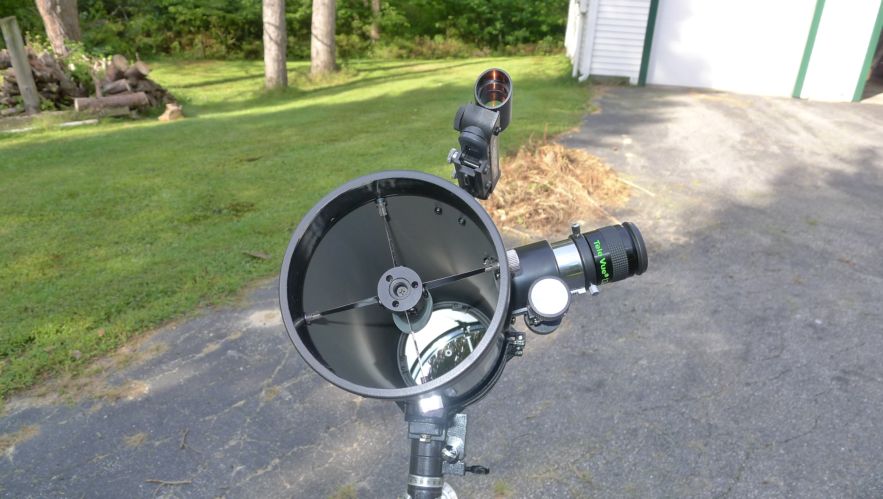
Looking down the tube. The primary has a center spot, there's a 4-vane secondary, and the central obstruction is about 30%
I did most of my observing with a 13 mm Nagler Type 6. Not fair! I hear you saying, but the Nagler corrects much of the edge distortion and I wanted a really accurate gauge of the scope's optics. The Expanse eyepieces are decent, and a cut above the Kellners supplied with the StarBlast Dob. I know of one serious observer who uses Expanse eyepieces in his binoviewer, in telescopes costing thousands of dollars. The point is that the scope is good enough to support the use of better eyepieces. At 35X, the 13 mm Nagler was just about the right power for framing the common summer objects. I even caught glimpses of NGC 7006, and NGC 6934, little distant globulars near Delphinus. Put in a higher power eyepiece and the Blinking Planetary will do its trick for you. With a 1.25" OIII filter, both halves of the Veil were dimly visible.
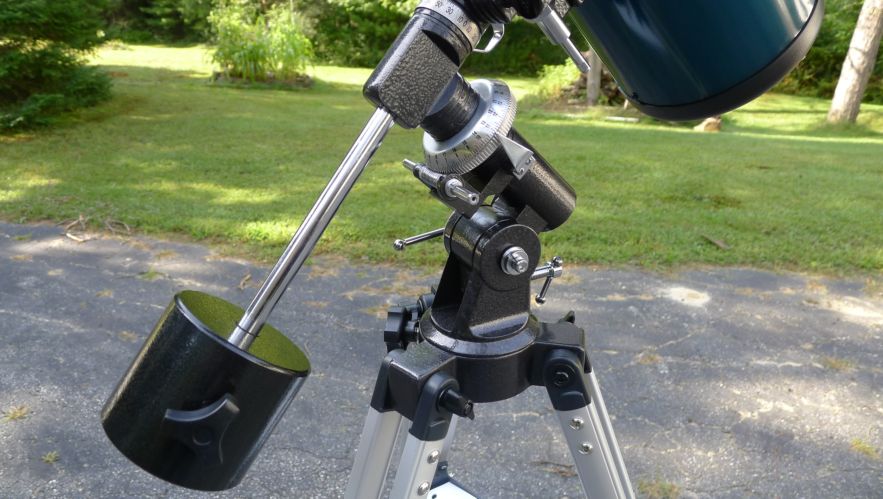
Better than I expected - the miniature EQ-1 mount
Is the scope perfect? Of course not. The most serious criticism I can find is the plastic focuser. Even the parts that look like chromed metal are just painted pieces of plastic. Over time, it will break. Our club donates StarBlast telescopes to local libraries as part of our Library Telescope Program, and I can tell you first hand that the focuser is the first thing that breaks. Orion will sell you replacements for around $20. Or, for a more permanent solution, rig a better focuser to the tube. Also, as the scope only weighs 20 lbs and is top-heavy, it is susceptible to getting bumped and knocked over in the dark. If you expect to have lots of kids (or adults!) running around at night, the Dob version might be a better choice. As mentioned before, the supplied cables will get in the way. The mount's altitude setting only has a stop in one direction, so if you aren't careful, you can tilt the entire spring-loaded mechanism backwards. At the very least, this will move the scope off target; at the worst, you risk tipping the entire telescope over.
I never thought I'd say this about a $219 telescope, but I was sad to see the Starblast equatorial go. If I didn't own 9 telescopes already, I'd probably buy one for myself. If you're looking for a small telescope for a budding science fan in your household, the StarBlast Equatorial is an excellent choice. So is the Dob. In fact, if you're brand new to this game, I'd think I'd still steer you towards the Dob - it's simpler, lighter, and cheaper. Not that you'd go wrong with this model. I polled the local club members who have owned both versions, and every one of them says they prefer the equatorial model. The fact that you have serious options in this price range is a boon to our hobby. Have I sold you yet? Good - go get one!!